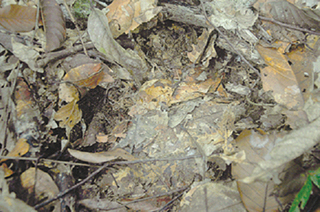Hope yet of finding more rhinos
Published on: Wednesday, December 07, 2016

Kota Kinabalu: A footprint believed to be that of a Sumatran rhino has been spotted deep in Sabah's east coast jungles, suggesting there is still hope of finding more of the species that was declared extinct in Malaysia in 2015.The discovery was made by a team of field researchers who took part in the Danum Valley Wildlife and Resources Survey 2016 who believed the footprint, measuring 23cm in length, might belong to an adult. According to a member of the research team, Sharon Koh, the discovery of the footprint indicates that.
ADVERTISEMENT
"We really hope so (Sumatran rhinos in the jungle)," said Sharon Koh, manager (Patrolling and Enforcement), Sabah Terrestrial Conservation Programme at WWF-Malaysia.The last two known Sabah rhinos left are at the Tabin Wildlife Centre. She said according to an expert, the possibility of a ghost population of Sumatran rhinos in Sabah cannot be ruled out."So we might have a ghost population where they suddenly appear after not being detected for a long time," she said, citing a case in Kalimantan and that of Iman, the last Sumatran rhino to have been found in Malaysia. She was captured in Danum Valley and later transported to the Borneo Rhino Sanctuary in 2014.
ADVERTISEMENT
While the discovery has given reason to cheer and hope, especially among wildlife conservationists, Koh admitted that some experts were doubtful whether the footprint was truly that of a Sumatran rhino."I leave it to the experts," she said, arguing that it cannot be a footprint of a young elephant for it if was, researchers would have spotted footprints of its mother.
ADVERTISEMENT
She said the team is planning to return to the site together with other wildlife conservation organisations and relevant government departments to conduct further research.Only three of the species, including the adult female Iman, have been captured from the jungles of Sabah – a male named Tam (found in 2008) and Puntong (2011).In its website, the Borneo Rhino Alliance says that even with three rhinos found within six years, the chances of more rhinos that can be found roaming in Sabah's jungles is "close to zero.' The major threats to the species are habitat loss due to forest conversion for agriculture and human settlements as well as poaching. According to Koh, at the area where the footprint was spotted there were signs of human encroachment. "We're worried about this and we hope we can do something very quickly," she said.Koh presented the research finding along with 10 other field survey teams during a seminar, Tuesday. The survey, jointly organised by the Yayasan Sabah Group and the Sabah Wildlife Department last August, was participated by 133 participants from various government departments, non-governmental organisations and academic institutions, covering a 3.5km radius of the Danum Valley Conservation Area (DVCA).The survey was conducted to acquire the latest information on wildlife diversity and richness in the area as well as to determine the presence of rare, threatened and endangered species.Survey information presented during the seminar will provide input for the mid-term review of the Danum. A new species of bird, the Spectacled Flowerpecker that was discovered in 2009 in Danum Valley Conservation Area (DVCA), is also among the latest secrets of the Sabah rainforest which have been unlocked and featured in a monograph entitled "Danum Valley The Rainforest."The monograph pays tribute to more than 400 research works done by Malaysian and foreign scientists from over 50 universities around the world in the DVCA over the last 25 years. It was co-authored by Hans Hazerbroek, Datuk Dr Tengku Zainal Adlin and Dr Waidi Sinun.According to Hazerbroek, the over 500-page monograph gives a deeper insight to readers into the Sabah rainforest through all the research works covering a variety of subjects from trees, soil, plants, animals and hydrology."We had to read all the reports and compile into an easy to understand texts that's now in this book," he said adding that the authors had also spent time in the jungle for the project.He assured that many will find the contents of the monograph an exciting read and learn about all the exciting discoveries in the jungle, including the flowerpecker."It's a new species to science that has never been found anywhere before," he said after the launching ceremony of the monograph, Tuesday.He said obviously there are still more secrets to be unlocked in the Sabah rainforests in time to come.YAYASAN Sabah took a bold step in 1981 not to log in Danum Valley and its rich biological diversity continues to be a source of motivation to preserve its uniqueness to this day."Looking at Danum Valley today, it was the best decision made," said its Director Datuk Sapawi bin Hj Ahmad. His speech was delivered by his deputy Datuk Rosmawati Lasuki.He noted that the area has become the pride of Sabahans and recently made headlines around the world with the discovery of at least 33 tallest tropical trees in the world. The trees stand 94 metres tall.He also said the Yayasan Sabah Group will continue to show its commitment to conservation not only in terms of forest protection but also guarding the quality and eco-system function of the forest through forest planting efforts.He noted that one of the show of commitments was through the DVCA Wildlife and Resources Survey 2016.He congratulated all 133 participants who took part in the survey, held last August, which aimed at acquiring the latest information on wildlife diversity and richness in the area, determining the presence of rare, threatened and endangered species, assess potential threats like poaching, fire and encroachment, among others.Stay up-to-date by following Daily Express’s Telegram channel.
Daily Express Malaysia




